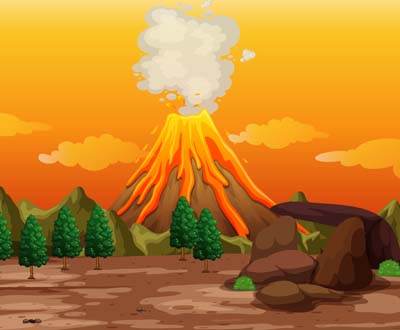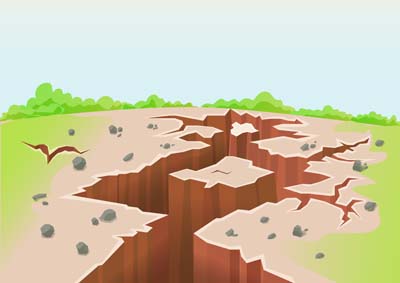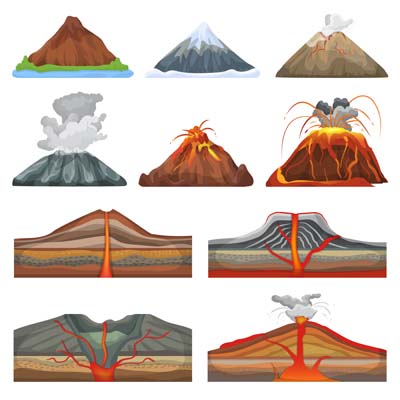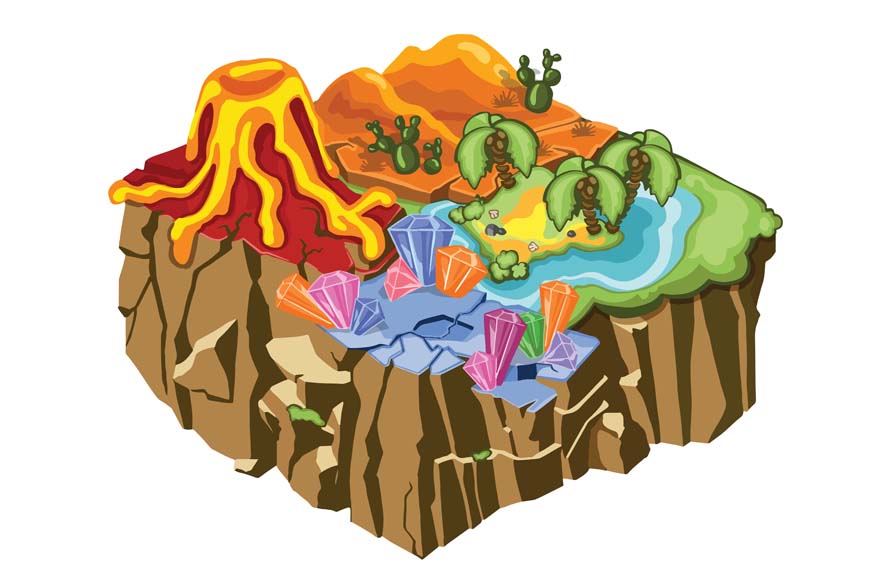Earthquakes and volcanoes are interconnected because they are caused by the release of heat and energy from the Earth’s core. When an earthquake occurs, it can lead to volcanic eruptions by shifting the tectonic plates. On the other hand, volcanoes can also cause earthquakes through the movement of magma, leading to changes in the landscape. The primary cause of both earthquakes and volcanoes is the movement of tectonic plates, especially where these plates interact at their edges and boundaries.
Volcanoes

A volcano is a hole in the Earth’s surface where lava escapes along with volcanic gases and ash. When a volcano erupts, it shows just how powerful and destructive nature can be. Interestingly, the magma that remains after an eruption can help create new soil over time. Volcanoes can be classified into three main types, which are outlined below.
Active volcanoes: Active volcanoes are those that erupt often and have a long record of eruptions. Their activity can significantly alter the surrounding landscape, and many of them are found along the “Ring of Fire” in the Pacific region.
Dormant volcanoes: Dormant volcanoes do not erupt regularly but have erupted in the past and could potentially erupt again someday.
Extinct volcanoes: Extinct volcanoes are viewed as dead; they have not erupted in a long time and are unlikely to erupt again. These volcanoes are the ones that erupted several years ago, and there are few or no possibilities left for their future eruption.
Earthquakes
Earthquakes are the shaking and trembling of the Earth’s surface caused by the movement of tectonic plates. This intense shaking happens when stress builds up in the Earth’s crust and is suddenly released. You can recognise an earthquake by the jolts that accumulate pressure on both sides of the rock layers, leading to changes in the landscape.

The tectonic plates form the Earth’s outer layer and are located beneath both land and water. When these plates shift, they can trigger volcanic eruptions and create mountains, as well as cause the ground to shake. Sometimes, the vibrations are so strong that they can lead to significant destruction. They can cause severe shaking and even generate tsunamis in the oceans, which are also very harmful.
Causes of Earthquakes
The main causes of earthquakes include the following:
Tectonic Plate Movement: This is the most frequent cause of earthquakes since tectonic plates are constantly shifting, affecting the Earth’s crust. The movement and collision of these plates can be very destructive, resulting in earthquakes of varying strengths. These earthquakes can be categorised into three types: constructive, destructive, and conservative.
Volcanic Eruptions: Another major reason for earthquakes is volcanic eruptions, which can severely impact areas with active volcanoes. Generally, the earthquakes triggered by these eruptions are mild, and the range is also limited. However, in rare instances, they can lead to significant damage to both life and property.
Geological Shifts: Faults, or shifts in the Earth’s crust, are another main reason for gradual geological changes over time. These faults are often caused by geological forces that fracture rocks and release substantial energy.
Human Activities: Human interference with the natural environment can disrupt the balance of the Earth’s crust. Activities such as detonating nuclear bombs and other weapons are examples of how humans can induce earthquakes. Additionally, mining operations pose a risk to geological stability.
Minor Causes: Smaller events like landslides, avalanches, and the collapse of heavy rocks can also lead to tremors in the Earth’s surface.
Effects of Volcanic Eruptions

The effect of a volcanic eruption can be both constructive and destructive.
Constructive effects
Land formation: Volcanic activity plays a major role in shaping the Earth’s landscape. When a volcano erupts, it pushes new materials up from beneath the surface, creating fresh landforms. A great example of this is the Hawaiian Islands, which were formed by numerous eruptions in the same area. Other island groups, like the Aleutian Islands, Mariana Islands, and Ryukyu Islands, also came into existence due to volcanic eruptions.
Emission of gases: When a volcano erupts, it releases a variety of gases, with sulfur dioxide being one of the most significant. This gas can rise into the stratosphere, where it transforms into sulfuric acid aerosols. Aerosols are tiny particles suspended in the air, similar to fog, where the particles are mostly water. These aerosols can linger in the atmosphere for years, leading to a cooling effect that lowers temperatures.
Volcanic lakes: Sometimes, after a major volcanic eruption, a large crater is left behind on the Earth’s surface. When the volcano becomes dormant, these craters can fill with water from rain, groundwater, or other sources, forming what we call crater lakes.
Destructive Effects
Impact on Climate: Volcanic eruptions can significantly alter the Earth’s climate because they release various gases into the atmosphere. These gases can have a major effect on weather patterns, leading to unpredictable and extreme weather events.
Pyroclastic Flows: During a volcanic eruption, one of the most dangerous phenomena is the formation of pyroclastic flows. These are fast-moving clouds of superheated gas and volcanic material, including small rocks and debris. They can travel at incredible speeds and are extremely hot, making them lethal to anyone who encounters them.
Volcanic Ash: Volcanic ash is made up of tiny pieces of rock, minerals, and sometimes volcanic glass. Inhaling this ash can be very harmful to both humans and animals, posing serious health risks.
Understanding the role of volcanoes and earthquakes in shaping the Earth’s surface is crucial for appreciating the dynamic nature of our planet. These natural phenomena not only sculpt the landscape but also impact human societies and the environment in profound ways. As we continue to study and monitor the causes of earthquakes and the effects of earthquakes and volcanic eruptions, we can better prepare for and mitigate their impacts.
At Center Point School, we emphasise the importance of geological studies to foster a deeper understanding of our planet and its evolution. By educating our students about these natural phenomena, we aim to equip them with the knowledge to appreciate and respond to the dynamic Earth we live on.





